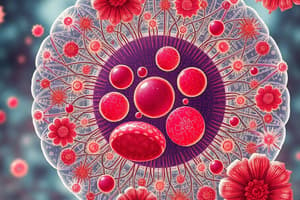Podcast
Questions and Answers
Which of the following statements about DNA replication is correct?
Which of the following statements about DNA replication is correct?
- DNA replication is a process that occurs in the nucleus of prokaryotic cells.
- DNA replication results in two identical daughter DNA molecules. (correct)
- DNA replication is a process that occurs in the cytoplasm of eukaryotic cells.
- DNA replication occurs in prokaryotic cells only.
What is the primary function of DNA replication?
What is the primary function of DNA replication?
- To repair damaged DNA in the cell.
- To produce new proteins for the cell.
- To provide genetic material for new cells during cell division. (correct)
- To facilitate the process of transcription.
Which of the following enzymes is primarily responsible for DNA replication?
Which of the following enzymes is primarily responsible for DNA replication?
- RNA polymerase
- DNA helicase
- DNA polymerase (correct)
- DNA ligase
In which cellular structure does DNA replication occur in eukaryotic cells?
In which cellular structure does DNA replication occur in eukaryotic cells?
What is the process of DNA replication initiated by?
What is the process of DNA replication initiated by?
Which of the following statements about DNA replication is true?
Which of the following statements about DNA replication is true?
What is the role of histones in the structure of DNA?
What is the role of histones in the structure of DNA?
What is the purpose of DNA replication during the cell cycle?
What is the purpose of DNA replication during the cell cycle?
Which enzyme is responsible for unwinding the DNA double helix during replication?
Which enzyme is responsible for unwinding the DNA double helix during replication?
What is the difference between the leading and lagging strands during DNA replication?
What is the difference between the leading and lagging strands during DNA replication?
What is the purpose of the $S$ phase during the cell cycle?
What is the purpose of the $S$ phase during the cell cycle?
What is the role of RNA during protein synthesis?
What is the role of RNA during protein synthesis?
Which type of RNA is responsible for carrying the genetic instructions from the nucleus to the ribosomes?
Which type of RNA is responsible for carrying the genetic instructions from the nucleus to the ribosomes?
What is the role of tRNA during protein synthesis?
What is the role of tRNA during protein synthesis?
What is the purpose of the stop codon during translation?
What is the purpose of the stop codon during translation?
What is the role of DNA polymerase during DNA replication?
What is the role of DNA polymerase during DNA replication?
Flashcards are hidden until you start studying
Study Notes
Cellular Organelles
- Mitochondria:
- Function: ATP production
- Have their own DNA and manufacture their own ribosomes
- Located in the mitochondrial matrix between the cristae
- Lysosomes:
- Function: digestion and denaturation of biological macromolecules
- Allow calcium release from bones
- Peroxisomes:
- Function: degradation of harmful substances, neutralizing oxygen free radicals
- Contain enzymes to convert hydrogen peroxide (H2O2) to water and oxygen
The Endomembrane System
- Comprises: nuclear envelope, endoplasmic reticulum, golgi apparatus, lysosomes, vesicles, and plasma membrane
- Functions: production, storage, and export of molecules, and degradation of harmful substances
Nucleic Acids
- DNA (Deoxyribonucleic Acid):
- Double-stranded helical molecule in the cell nucleus
- Provides instructions for protein synthesis
- Replicates before cell division to ensure genetic continuity
- RNA (Ribonucleic Acid):
- Single-stranded molecule
- Carries instructions for protein synthesis from DNA to ribosomes
- Types: mRNA, tRNA, rRNA
Chromatin and Chromosomes
- Chromatin:
- 30% DNA, 60% histone proteins, and 10% RNA chains
- Histones package and regulate DNA, shut down DNA when needed, and activate DNA segments for protein production
- Chromosomes:
- Formed from chromatin during cell division
- Each chromosome has a p-arm and q-arm, hinged at the centromere
Cell Division
- Meiosis:
- Halves chromosome number in daughter cells (gametes)
- Combines genetic information from parents during sexual reproduction
- Mitosis:
- Duplicates chromosomes, with one set given to each new daughter cell
- Occurs in response to growth, injury, and aging
The Cell Cycle
- Consists of: Interphase and Cell Division
- Interphase:
- Grows and prepares for cell division
- DNA replication occurs in the S phase
- Cell Division:
- Mitosis and cytokinesis
Transcription and Translation
- Transcription:
- Process of converting DNA code to RNA
- Occurs in the nucleus
- Translation:
- Process of converting RNA code to amino acid sequence
- Occurs in the cytoplasm
Proteins
- Composed of long, folded chains of amino acids
- Determine protein structure and function
- Genetic code determines protein production
Plasma Membrane and Cytosol
- Plasma membrane:
- Phospholipid bilayer structure
- Semi-permeable, allowing selective passage of molecules
- Cytosol:
- Fluid part of the cytoplasm
- Site of many metabolic reactions
Studying That Suits You
Use AI to generate personalized quizzes and flashcards to suit your learning preferences.




